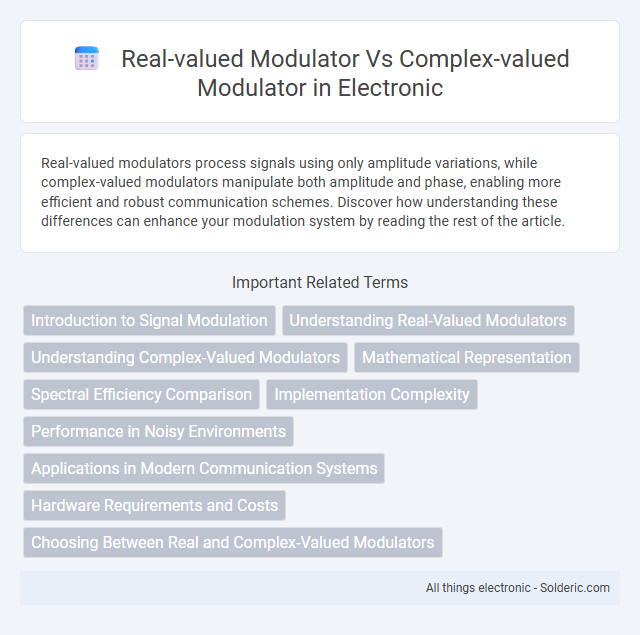Real-valued modulators process signals using only amplitude variations, while complex-valued modulators manipulate both amplitude and phase, enabling more efficient and robust communication schemes. Discover how understanding these differences can enhance your modulation system by reading the rest of the article.
Comparison Table
| Feature | Real-Valued Modulator | Complex-Valued Modulator |
|---|---|---|
| Signal Representation | Real-valued signals (single dimension) | Complex-valued signals (magnitude and phase) |
| Bandwidth Efficiency | Lower bandwidth efficiency | Higher bandwidth efficiency using I/Q components |
| Implementation Complexity | Simple hardware and algorithms | More complex hardware and signal processing |
| Noise Performance | Less robust in noisy channels | Improved noise resilience due to complex baseband processing |
| Applications | Basic modulation schemes (AM, FM) | Advanced modulation (QAM, OFDM, MIMO) |
| Phase & Amplitude Control | Limited phase control | Precise phase and amplitude manipulation |
Introduction to Signal Modulation
Signal modulation involves altering a carrier signal to transmit data effectively, with real-valued and complex-valued modulators serving distinct roles. Real-valued modulators manipulate amplitude or frequency of a single carrier wave, making them simpler but less efficient for bandwidth use. Complex-valued modulators encode information onto both the amplitude and phase of the carrier, enabling higher data rates and better resistance to noise, which enhances Your communication system's performance.
Understanding Real-Valued Modulators
Real-valued modulators process signals using purely real numbers, simplifying hardware implementation and reducing computational complexity compared to complex-valued modulators that utilize both real and imaginary components for enhanced signal representation. Real-valued modulators are widely used in applications where phase information is less critical, enabling efficient amplitude modulation schemes such as PAM (Pulse Amplitude Modulation). Understanding the trade-off between simplicity in real-valued modulation and the richer signal characterization in complex-valued modulation is essential for optimizing communication system design.
Understanding Complex-Valued Modulators
Complex-valued modulators process both amplitude and phase information, enabling efficient representation of signals in quadrature, which enhances spectral efficiency and robustness in communication systems. Unlike real-valued modulators that manipulate only signal amplitude, complex-valued modulators employ in-phase (I) and quadrature (Q) components to modulate signals accurately in complex baseband. This dual-component modulation is crucial for advanced modulation schemes like QAM and phase-shift keying, improving bandwidth utilization and signal fidelity.
Mathematical Representation
Real-valued modulators use real-valued signals represented as functions of time or frequency, typically expressed as Am(t)cos(2pf_ct), where Am(t) is the real amplitude envelope and f_c is the carrier frequency. Complex-valued modulators represent signals as complex functions, often in the form S(t) = I(t) + jQ(t), where I(t) and Q(t) are in-phase and quadrature components, allowing for efficient manipulation of amplitude and phase in the complex plane. Your choice between real and complex modulation affects the mathematical tools needed for signal analysis and processing, such as Fourier transforms and complex baseband representation.
Spectral Efficiency Comparison
Real-valued modulators typically exhibit lower spectral efficiency compared to complex-valued modulators because they transmit information using only amplitude variations on a single dimension. Complex-valued modulators leverage both amplitude and phase variations across two dimensions (in-phase and quadrature components), effectively doubling the data rate within the same bandwidth. Your choice of modulator directly impacts the spectral efficiency, with complex-valued schemes offering superior performance for bandwidth-limited communication systems.
Implementation Complexity
Real-valued modulators typically offer lower implementation complexity due to simpler hardware requirements and reduced computational load. Complex-valued modulators demand more sophisticated digital signal processing algorithms and hardware capable of handling both real and imaginary components, increasing design complexity. The choice between real-valued and complex-valued modulators directly impacts system performance trade-offs in terms of processing power, power consumption, and hardware cost.
Performance in Noisy Environments
Real-valued modulators typically exhibit simpler implementation but suffer from reduced noise resilience compared to complex-valued modulators, which leverage both amplitude and phase information for enhanced signal clarity. Complex-valued modulators improve performance in noisy environments through better spectral efficiency and robustness against interference, making them ideal for high-demand communication systems. Your choice of modulator significantly impacts system reliability and data integrity under varying noise conditions.
Applications in Modern Communication Systems
Real-valued modulators are widely used in basic communication systems for simple amplitude or frequency modulation schemes, ideal for applications such as analog radio broadcasting and low-complexity wireless links. Complex-valued modulators enable advanced modulation formats like QAM and OFDM, essential for high data rate transmissions in 4G/5G cellular networks, Wi-Fi, and satellite communications. Your choice between the two impacts spectral efficiency, signal robustness, and overall system performance in modern digital communication environments.
Hardware Requirements and Costs
Real-valued modulators generally require simpler hardware components such as digital-to-analog converters and mixers operating on single-dimensional signals, resulting in lower implementation costs and reduced power consumption. Complex-valued modulators handle both in-phase (I) and quadrature (Q) components, necessitating more sophisticated hardware like dual-channel DACs and mixers, which increases complexity, size, and overall system cost. The choice between real-valued and complex-valued modulators significantly impacts the design budget and resource allocation in communication system hardware.
Choosing Between Real and Complex-Valued Modulators
Choosing between real-valued and complex-valued modulators depends on the application's bandwidth and signal representation requirements. Real-valued modulators are simpler and suitable for baseband or low-frequency signals, whereas complex-valued modulators efficiently handle quadrature amplitude modulation (QAM) and orthogonal frequency-division multiplexing (OFDM) in high-bandwidth communication systems. Performance metrics such as spectral efficiency and noise resilience often favor complex-valued modulators in advanced digital communication designs.
Real-valued modulator vs complex-valued modulator Infographic

 solderic.com
solderic.com